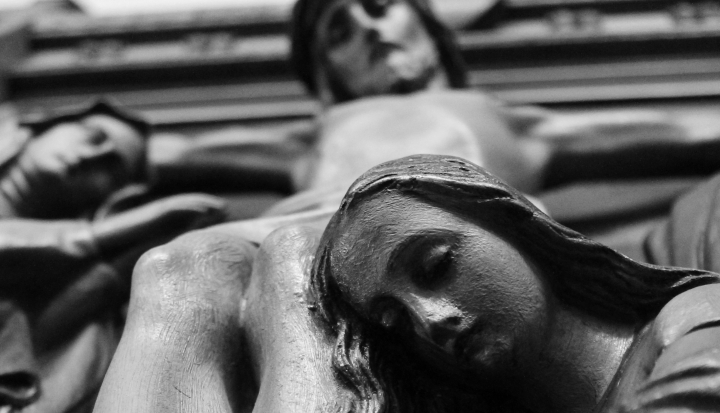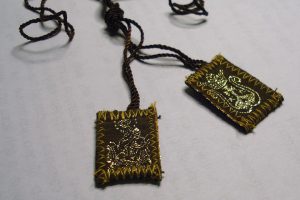It all comes down to the Resurrection. Twenty centuries of Christianity—and the faith of billions—rest on this singular event. And who is the primary witness to this momentous miracle, the first person to whom Jesus revealed himself? It would seem that fact would be such an essential element of the faith that all Christians should be able to respond without even thinking—as they do to similar questions, like “Who is Jesus’ mother?” or “Which apostle betrayed Jesus?”
But the first witness to the Resurrection—as all four gospel writers agree—was a woman whose name and reputation have become so misunderstood, misinterpreted, and misconstrued over the centuries that she is more commonly, though erroneously, remembered as a prostitute than as the faithful first bearer of the Good News.
That woman is Mary of Magdala and, finally, her centuries-old case of mistaken identity is being rectified.
Now that scripture scholars have debunked the myth that she and the infamous repentant sinner who wiped Jesus’ feet with her tears are one and the same woman, word is trickling down that Mary Magdalene’s penitent prostitute label was a misnomer. Instead, her true biblical portrait is being resurrected, and this “apostle to the apostles” is finally taking her rightful place in history as a beloved disciple of Jesus and a prominent early church leader.
“We’re trying to right a 2,000-year-old wrong,” says Christine Schenk, C.S.J., executive director of FutureChurch, a Cincinnati-based church-reform organization that launched nationwide observances of Mary Magdalene’s feast day (July 22) two years ago. The idea quickly grew from a handful of celebrations to nearly 130 prayer services last year at Catholic parishes, Newman centers, schools, retreat houses, hospital chapels, motherhouses, and in small faith communities.
“People see this as a positive, constructive way to show they support women’s equality,” says Schenk, who believes reclaiming Mary Magdalene’s reputation as an early church leader will have implications for women’s leadership in the church today, including the ordination of women.
As part of a Women in Church Leadership project co-sponsored by FutureChurch and Call to Action, celebrations were created to accomplish two goals: to provide opportunities for visible liturgical roles for women and to disseminate current biblical scholarship that counters the myth of Mary Magdalene as public sinner.
Badgered witness
Many cradle Catholics are shocked to learn that there is no biblical evidence that Mary of Magdala was a prostitute or public sinner. She is mentioned 12 times in the New Testament—making her the second most mentioned woman, after the Virgin Mary. Most references are found in the Crucifixion and empty tomb narratives, where she is portrayed as a loyal disciple at the foot of the cross and as one of the first witnesses to the Resurrection.
Unlike other women in the Bible, Mary of Magdala is not identified in relation to another person; she is not anyone’s mother, wife, or sister. Instead, she is called Mary of Magdala, a title that implies some prominence in the city, a center of commercial fishing on the northwest bank of the Sea of Galilee. She left her home to follow Jesus, and it is believed she was among several well-off, independent women who financially supported Jesus’ ministry.
These female followers of Jesus—disciples, really—became central when everything started to fall apart. While others fled, the women were faithful, and they were led by Mary of Magdala.
Details differ in the four, gospel accounts of the Resurrection as to the number of heavenly visitors at the tomb, which women accompany Mary Magdalene to anoint the body, and whether or not the women are believed when they run to tell the news of Christ’s Resurrection. But on this all four gospels agree: Mary Magdalene was faithful until the end, and her faithfulness was rewarded with an appearance by the risen Lord.
“It’s really remarkable that all four gospels have the same story,” says scripture scholar Mary Thompson, S.S.M.N., adjunct professor of religious studies at Canisius College in Buffalo, New York and author of Mary of Magdala: Apostle and Leader (Paulist, 1995). “You can be sure that if it had been possible to eliminate those women who went out from the empty tomb, [the gospel writers] would have done it,” because of the prevailing attitude toward women in those times, she says.
Despite the fact that legally a woman’s testimony at that time was considered invalid, the authors of the four gospels all make women the primary witnesses to the most important event of Christianity. That leads Thompson and others to believe that detail has historical validity.
In Matthew’s version (28:1-10) Mary Magdalene and “the other Mary” first learn of Jesus’ Resurrection from an angel at the tomb, who tells them to “go quickly and tell his disciples.” As they leave they are met by Jesus, who also instructs them to spread the Good News to the others.
Likewise in Mark’s account (16:1-8) Mary Magdalene is accompanied by Mary, the mother of James, and Salome to anoint Jesus’ body. But inside the empty tomb they find an angel who tells them Jesus has been raised from the dead. Again, Jesus first appears to Mary Magdalene, but when she tells the disciples, they do not believe her.
Luke (24:1-12) says the three women are Mary Magdalene; Mary, the mother of James; and Joanna, and that they first find the stone rolled away and are told by two men “in dazzling clothes” that Jesus has risen from the dead. The other disciples do not believe their “idle tale,” and Peter runs to the tomb to see for himself the burial cloths.
In John’s Resurrection account (20:1-18) Mary Magdalene goes to the tomb alone, sees that the stone has been rolled away, and runs to get Peter. What follows are parallel stories: Verses 3-10 describe how Peter and the disciple Jesus loved witness the burial cloths, but “they did not understand”; while verses 10-18 tell the story of Jesus’ appearance to Mary of Magdala.
“Woman, why are you weeping?” Jesus asks his beloved friend, who is lost in her grief. Mary Magdalene initially mistakes Jesus for the gardener, who had just asked the same question of her. But then she turns and in her recognition calls out, “Rabbouni” (meaning “rabbi” or “teacher”). Then Mary of Magdala goes to tell the disciples, “I have seen the Lord.”
A Mary mixup
If Mary of Magdala is consistently portrayed as a crucial player in arguably the most important event of Christianity, why is she not remembered for this role?
“Unquestionably and dearly, Mary of Magdala was the primary witness to the Resurrection of Jesus Christ, and our whole Christianity depends on that,” says Thompson.
The problem lies in the alternate image of Mary Magdalene as the fallen and redeemed woman, as the epitome of sensuality and spirituality—an image that has become ingrained in the imaginations of centuries of Christians and one that continues to be fostered through depictions in art, literature, and even movies.
So how did Mary of Magdala become a prostitute some several hundred years after her death?
The short answer is that Mary Magdalene has been confused with several other women in the Bible, most significantly—and ultimately problematically—with the unnamed sinner in Chapter 7 of Luke. In that story, a woman bathes Jesus’ feet with her tears, anoints them with ointment from her alabaster jar, and dries them with her hair. When the Pharisees object, noting that she is a known sinner, Jesus admonishes them and forgives her “because she has shown great love” (Luke 7:47). Nowhere does it say that this woman was a prostitute, and nowhere is she identified as Mary of Magdala.
The confusion may have come from the proximity of that passage to the one that identifies Mary of Magdala by name as a follower of Jesus who had had seven demons cast out of her (Luke 8:2). Although previously interpreted as referring to sexual sin, the mention of seven demons is now believed to mean illness, most likely mental illness.
The waters get even muddier when this unnamed sinner gets lumped in with another Mary—Mary of Bethany, Martha and Lazarus’ sister—who also anoints Jesus’ feet and wipes them with her hair, as described in Chapter 12 of John’s gospel. An earlier version of this story in Matthew refrains from naming this woman. In Matthew this woman is a close friend of Jesus—not a stranger with a reputation as a sinner.
Some believe the conflation of Mary of Bethany and Mary of Magdala results not just from their shared name but also from the presence of the alabaster jar of perfumed oil. It’s easy to see why the sinful woman who anoints Jesus’ feet is confused with Mary of Bethany, who does the same. It’s possible that the shared symbols of incense and tears have historically united these women with Mary of Magdala, who was among the women who brought jars of perfumed oil to the tomb to anoint Jesus’ body.
Sister Barbara Bowe, R.C.S.J., New Testament professor at Catholic Theological Union in Chicago, says a similar thing happened to several “Johns” and the unnamed “beloved disciple.” It was a tendency, especially in the earlier period, she says. “Characters get blended together and homogenized in ways that don’t preserve the integrity of the texts.”
Although the decline of Mary of Magdala’s reputation as apostle and leader most likely began shortly after her death, the transformation to penitent prostitute was sealed on Sept. 14, 591, when Pope Gregory the Great gave a homily in Rome that pronounced that Mary Magdalene, Luke’s unnamed sinner, and Mary of Bethany were, indeed, the same person.
“She whom Luke calls the sinful woman, whom John calls Mary, we believe to be the Mary from whom seven devils were ejected according to Mark,” Gregory said in his 23rd homily. “And what did these seven devils signify, if not all the vices? . . . It is clear, brothers, that the woman previously used the unguent to perfume her flesh in forbidden acts . . .”
Few ascribe malicious intent to Gregory (“Although I have a hard time with the ‘Great’ part,” says Thompson), who most likely wanted to use the story to assure converts that their sins would be forgiven. Indeed, the gospel passage is a powerful one—and can still be, without being inaccurately attached to Mary Magdalene.
“I have people who tell me,‘I liked her as a prostitute,’ ” says Schenk. “That story spoke very deeply of the profundity of forgiveness.”
But Christians deserve to hear about the multiplicity of women in scripture, argues Schenk. And reducing one of the most important leaders of the early church to a prostitute has exacted a price, especially for women, by feeding into the notion that women are either madonnas or whores.
“This fans the flames of the stereotype of women as sinful,” says Bowe. “For women today who look to the Bible for inspiration and liberation, their choices are limited enough. When we suddenly cut Mary Magdalene off at the knees and turn her into some evil sex pervert, we deprive men and women, but especially women, of a figure with whom they can identify.”
Mary Magdalene’s story and that of Luke’s unnamed sinner need to be separated, Bowe says. “Then you can take them each in their integrity,” she says. The passage in Luke is powerful, “But it’s not Mary Magdalene.”
Lead us not
While no pope or other person deserves the singular blame, many feminist theologians have no doubt that Mary Magdalene’s reputation was deliberately altered to suppress women’s leadership in the church in those early centuries. Given the gospel accounts, her importance could not be denied—but her character could be changed to be less threatening.
“To have silenced and suppressed the tradition with respect to the most prominent woman in Christian circles isn’t an accident,” says Jane Schaberg, a professor of religious studies and women’s studies at the University of Detroit-Mercy who is writing a book on Mary of Magdala.
Schenk admits she wouldn’t use the word conspiracy, but she says, “It’s clear there wasn’t much resistance to changing her image. I’m not sure we can understand the degree of resistance and anger and determination on the part of male leadership to put female leaders back in their place. Unfortunately, that continues today.”
That women were leaders in the early Jesus movement is becoming clearer and more commonly accepted among scholars. Not only do several biblical passages describe them, but apocryphal, noncanonical writings also portray women as apostles, deacons, and co-workers. Studies of ancient burial inscriptions also have confirmed these titles—as well as the feminine presbytera—for women in the first centuries.
Women play a prominent role in the so-called gnostic gospels—writings that, though not included in the official canon, provide important historical evidence about the church of the first centuries.
For example, in the Gospel of Mary—the only apocryphal text named for a woman—Mary Magdalene is depicted as a visionary who receives secret revelations from Jesus, much to the chagrin of Peter. “Mary Magdalene, by virtue of her encounter with Jesus in John 20, was regarded as someone who was a special channel of secret knowledge,” Bowe says.
A more egalitarian, shared leadership was practiced among gnostic sects, with Mary of Magdala and other women figuring prominently. But as the early Christian church struggled for legitimacy, a male-dominated, hierarchical style of leadership prevailed. “The gnostic materials are full of the theme of opposition to Mary Magdalene’s leadership,” says Schaberg. “To put it simply, the people who opposed her won out.”
Others believe the characters of Mary of Magdala and Peter represent not the actual historical people but rather are used as literary devices in many gnostic writings.
“Peter is the symbol of what he is today—the power structure—while Mary Magdalene represents the pattern for the role of women in the early church,” says Thompson. “Two competing visions of church were jockeying for position, and it’s obvious which one won out. Women were already being subordinated. Patriarchal forces were trying to quell them.”
Thus the stage was set for Mary of Magdala to become denigrated as a sexual sinner and to lose her legacy as the first evangelist of the Good News of Jesus’ Resurrection.
Thompson and other feminist Christians associate some of the loss of Mary Magdalene’s legacy with the rise of a celibate clergy in the fourth and fifth centuries.
“This seems to have been a creeping effect of patriarchy,” says Thompson. “I think we have to ponder the enormity of what happened to Mary Magdalene. The implications are still with us today.”
Interestingly, the Eastern church took a different tack with Mary Magdalene. “They never fell for the prostitute fallacy,” says Thompson. “She is honored according to the biblical portrait.”
A legend in the Eastern tradition has Mary of Magdala traveling to Rome and appearing before the court of Emperor Tiberius. When she tells Tiberius about Jesus’ death and Resurrection, he challenges her story, saying no one could rise from the dead any more than an egg in a dish on the table could turn red.
With that, according to the legend, Mary picked up an egg and it turned bright red in her hand. To this day, icons of Mary Magdalene often depict her holding an egg, and Eastern Christians still color their Easter eggs a bright red.
In the West, however, the image of Mary Magdalene as sensual temptress is deeply entrenched. Even today the prostitute continues to be reinforced by popular culture.
Few can forget Mary Magdalene’s character sensually singing “I Don’t Know How to Love Him” in the ’60s musical, and later the movie, Jesus Christ Superstar. Although the portrayal poignantly depicted the depth of her devotion and deep love for Jesus, it unfortunately tainted it with an oversexualization of her character.
The sexy saint stirred up even more controversy in Martin Scorsese’s 1988 movie, The Last Temptation of Christ. Based on the novel by Nikos Kazantzakis, the film includes a sex scene between Mary Magdalene and Jesus, actually a dream sequence of what might have happened if Jesus had not been crucified. The film also erroneously identifies Mary Magdalene as the woman stoned for adultery in John 8:3-11.
But 20th-century artists aren’t the first to be misled into using the image of Mary Magdalene as temptress. In paintings throughout history, she is often pictured bare-breasted, and more often than not, clothed in red, the color of passion.
The vamp revamped
Today, reclaiming Mary Magdalene’s rightful role as apostle and leader remains an uphill battle, her supporters say. “The biblical scholarship is still relatively new,” says Thompson.
The news is just beginning to filter down to people in the pews. The feast day celebrations sponsored by FutureChurch and Call to Action are one way many Catholics are getting reintroduced to Mary of Magdala.
“I’ve long been an admirer of Mary Magdalene,” says Janelle Lazzo of Kansas City, Missouri, who once chose “sinner1” as her computer password because of her strong connection to the story in Luke.
“I thought if Jesus loved her that much with her various shortcomings, my own might not look so bad to him either. Once I realized what a pivotal role she had in his ministry, I was more than hooked,” Lazzo says.
Through her local Call to Action chapter, Lazzo helped organize and presided at a Mary Magdalene prayer service on her feast day at St. Francis Xavier Church in Kansas City. The service featured a proclamation of the Resurrection account from John, inclusive-language hymns and prayers, and time for personal sharing among the 60 or so gathered. Storyteller Sister Lillian Harrington, O.S.B. read a “Letter from Mary of Magdala,” in which a fictionalized Mary describes her true role in Jesus’ ministry.
In Indianapolis, Call to Action leaders organized seven observances last July. Organizer Lynette Herold, who attended several, including a Mass at her own parish, says the mood was energizing.
“It was very freeing, especially for the women,” she says. “It can be hard to relate to women in the Bible. So many of the stories are so negative. With Mary Magdalene, we’re finally getting another side of the story.”
Although she noticed that some participants wanted to hold onto the image of the penitent prostitute, Herold believes the “woman as temptress” monopoly must be broken. “We just don’t hear the women who were leaders and disciples proclaimed very loudly. Many people can’t admit that women had a key role in Jesus’ time. Because if we admit that, we have to ask why it isn’t happening now.”
It’s precisely that connection between the reinterpretation of the Mary Magdalene story and contemporary calls for expanded roles for women in the Catholic Church that has some Catholics concerned.
Although nearly all modern scripture scholars agree that the prostitute label is mistaken, not everyone is comfortable with the way her story is being retold. Some say feminists are hijacking Mary Magdalene’s story to serve their own agendas.
A 1998 article in the ultraconservative Catholic newspaper The Wanderer compared the new scholarship about the “historical Magdalene” to the “historical Jesus” movement in biblical studies. The church reformers—blatantly described as “heretics”—are said to be “distorting the historical figure of Mary Magdalen[e] in their crusade for a laywoman-run church.”
While feminist theologian Schaberg certainly isn’t in the same camp as The Wanderer, she nonetheless cautions against contemporary legend-making that is not grounded in serious biblical scholarship.
“I hope the efforts to reclaim Mary Magdalene will look more carefully at her tradition,” she says. “These efforts have to take into account the serious struggle New Testament scholars have with this material.”
But Schenk and others insist they are merely trying to right a centuries-old wrong—a correction that happens to provide a positive role model for contemporary women in the church. “I just think this has been a terrible injustice,” says Schenk. “I think of all the Christian women who need positive role models from scripture.”
With the prostitute baggage properly disposed of, Mary of Magdala can emerge as a model of a faithful, devoted follower of the Lord, as well as a strong, independent leader in the early church. Her leadership can motivate women of the 21st century, says Thompson.
“Mary of Magdala didn’t ask anybody whether or not she could lead. She simply led,” she says. “And that’s what women have to do today. Just do it.”
This article appeared in the April 2000 issue of U.S. Catholic (Vol. 65, No. 4, pages 12-16).
Image: Flickr photo cc by GlasgowAmateur
Correction: Sept. 5, 2023
An earlier version of this article incorrectly stated that Pope Gregory I gave a homily on Mary of Magdala on Sept. 14, 1591. The correct date is Sept. 14, 591.















Add comment